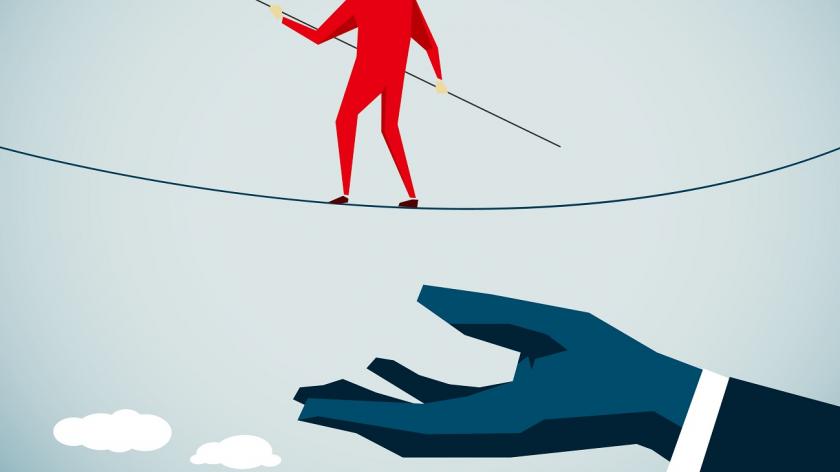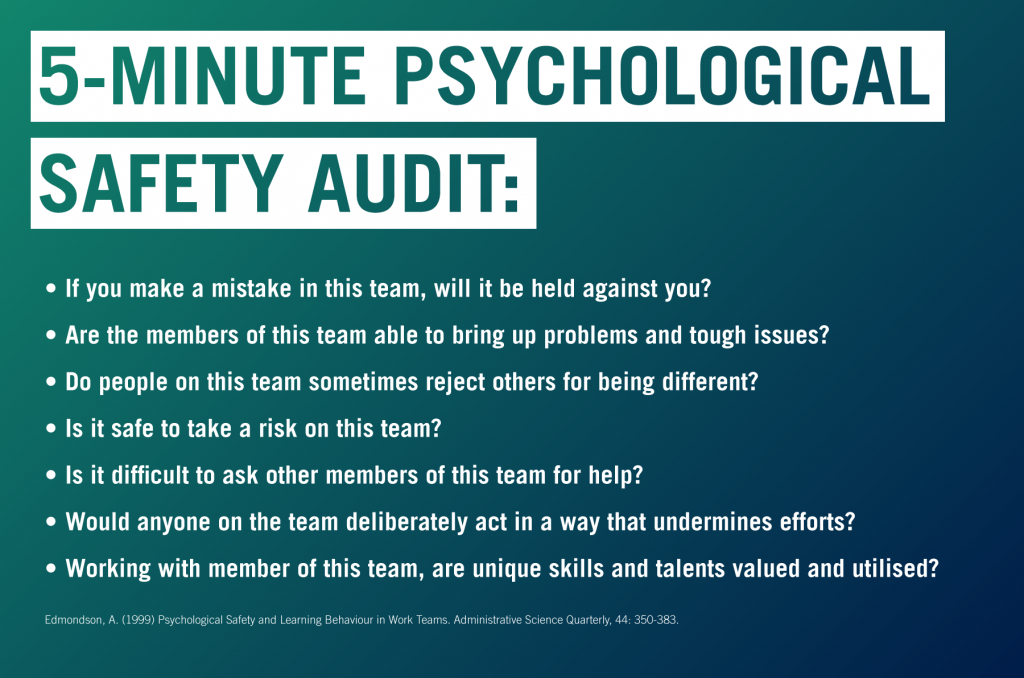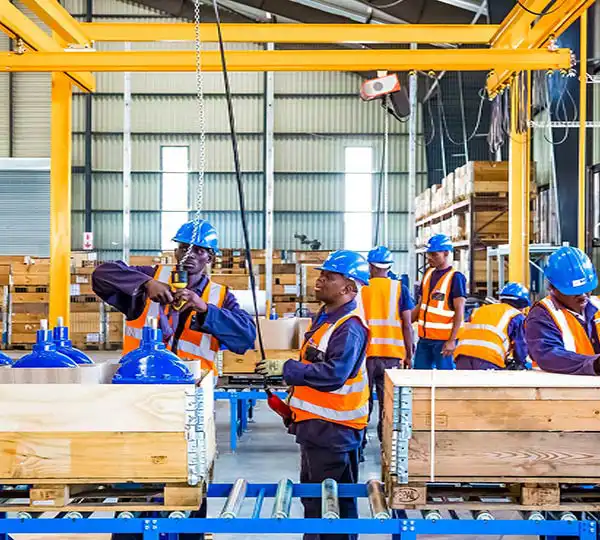
Driving Innovation Through Psychological Safety
In today’s fast-paced and competitive business landscape, innovation has become the lifeblood of organisations striving for success. However, fostering innovation is not as simple as flicking a switch. It requires a supportive environment that encourages risk-taking, collaboration, and the sharing of diverse ideas.
This is where psychological safety steps in as a powerful catalyst. Coined by Amy Edmondson in her influential book “The Fearless Organisation,” psychological safety is the cornerstone of building a culture that fuels innovation.
In this article, we will delve into the concept of psychological safety, explore its significance for driving innovation, and provide practical strategies to cultivate it within your organisation.
What is psychological safety?

Imagine a workplace where team members feel like tightrope walkers, carefully balancing their words and ideas, afraid of stumbling and facing repercussions. Now, picture a different scenario—a workplace where team members feel like trapeze artists, supported by a safety net that encourages them to take daring leaps and showcase their full potential. That safety net is psychological safety.
Psychological safety, as described by Amy Edmondson, is the foundation of a workplace culture that values openness, collaboration, and growth. It’s like a greenhouse for ideas to flourish, where people can voice their thoughts, express concerns, and share innovative solutions without fear of judgment or negative consequences.
Just as the safety net gives trapeze artists the confidence to perform daring aerial feats, psychological safety empowers individuals to take interpersonal risks, fostering a culture of trust, engagement, and ultimately, innovation.
Why is psychological safety important for innovation?

Innovation thrives in environments where ideas are nurtured, collaboration is embraced, and individuals feel empowered to take risks. This is where psychological safety becomes a crucial ingredient for driving innovation within organisations.
When psychological safety is present, team members are like explorers, fearlessly venturing into uncharted territories. They feel safe to share their unique perspectives, experiment with new approaches, and challenge the status quo without the fear of ridicule or reprisal. Psychological safety encourages individuals to take intellectual risks, fostering a climate where creativity can flourish.
Amy Edmondson emphasises in “The Fearless Organisation” that psychological safety allows team members to bring their authentic selves to work, fostering trust, open communication, and psychological well-being. When individuals feel safe to contribute their ideas and insights, it enhances engagement and collaboration, leading to more diverse and innovative solutions.
By cultivating psychological safety, organisations unlock the full potential of their workforce. Employees are more likely to explore unconventional ideas, offer constructive feedback, and learn from failures, all of which are essential elements of an innovative culture. Psychological safety not only ignites the spark of innovation but also fuels the continuous improvement that drives organisations forward.
Benefits of creating a psychologically safe environment

Innovation thrives when individuals feel safe expressing their ideas, taking risks, and collaborating with others. Psychological safety plays a pivotal role in unlocking these benefits, resulting in numerous positive outcomes for organisations.
When people feel psychologically safe, they are more likely to:
- Share their ideas, even if they are different
A psychologically safe environment encourages individuals to voice their unique perspectives and innovative ideas without fear of judgment. For example, at Google, one of their findings from “Project Aristotle” was that teams with higher psychological safety had more equal participation and a greater number of ideas shared, leading to increased innovation and team performance.
- Take risks and experiment
Psychological safety empowers individuals to step outside their comfort zones, take calculated risks, and experiment with new concepts. For instance, at 3M, their renowned “15% time” policy allows employees to spend a portion of their work hours pursuing their own innovative projects. This culture of psychological safety has resulted in breakthrough inventions like Multilayer Optical Film, Cubitron Abrasive Grains, and Post-it notes amongst others.
- Be creative and solve problems
In a psychologically safe environment, individuals are free to explore creative solutions and think outside the box. They can challenge existing processes, generate fresh ideas, and find innovative ways to solve complex problems. Pixar Animation Studios is known for creating a psychologically safe environment where their teams engage in open and honest discussions, leading to creative collaborations and groundbreaking animated films.
- Collaborate with others
Psychological safety fosters an atmosphere of trust, where individuals are more willing to collaborate, share knowledge, and leverage diverse perspectives. For example, IDEO, a global design and innovation consultancy, values psychological safety as a core principle in its design thinking process. This inclusive environment encourages teams to collaborate openly, sparking creative ideation and driving innovation.
These benefits translate into tangible outcomes for organisations, including:
- Increased innovation, driving continuous improvement, and keeping organisations at the forefront of their industries.
- Improved problem-solving capabilities through diverse perspectives, robust discussions, and the exploration of multiple solutions.
- Increased creativity, fostering an environment that values innovation and encourages a continuous flow of creative ideas.
- Enhanced collaboration, strengthening teamwork, fostering collective ownership, and maximising the impact of collective efforts.
- Increased employee engagement, leading to higher levels of motivation, productivity, and retention.
How to Create a Psychologically Safe Workplace

Creating a psychologically safe environment is crucial for fostering a positive and productive workplace. Here are some practical strategies that organisations can implement:
Set clear expectations and norms
Make it a priority to establish clear behavioral expectations and norms that promote respect, inclusivity, and open communication. Encourage team members to actively listen to each other during meetings, ensuring that everyone feels heard and valued.
Provide regular feedback
Feedback is essential for growth and development. Ensure that feedback is given regularly and constructively, focusing on both strengths and areas for improvement. This allows employees to understand their progress, make necessary adjustments, and feel supported in their professional journey.
Celebrate successes
Recognise and celebrate achievements to foster a positive and supportive work environment. Encourage a culture of appreciation by acknowledging individual and team accomplishments. This can be as simple as a team-wide email expressing gratitude or a monthly recognition programme.
Create a culture of learning and development
Encourage continuous learning and provide opportunities for personal and professional growth. Offer training sessions, workshops, or online courses to enhance skills and knowledge. This shows a commitment to employee development and encourages a growth mindset within the organisation.
Foster a sense of belonging
Foster an environment where every team member feels a sense of belonging and inclusion. Encourage collaboration and value diverse perspectives. Organise team-building activities that promote interaction and help team members get to know each other on a personal level.
Address conflict constructively
Conflict is a natural part of any workplace. However, it’s essential to address it constructively. Provide conflict resolution training to managers and team members to equip them with effective communication and problem-solving skills. Encourage open dialogue, active listening, and finding common ground.
Create a supportive and caring environment
Show genuine care for the well-being of your employees. Offer resources for mental health support, work-life balance, and stress management. Consider implementing flexible working hours or providing access to wellness programmes that promote physical and emotional well-being.
5-Minute Psychological Safety Audit
Assessing the level of psychological safety within your organisation is an essential step toward fostering a supportive and inclusive work environment. Take a few minutes to conduct this simple audit, inspired by the work of Amy Edmondson (The Fearless Organisation).

#1. Evaluate communication channels
Consider the various channels used for communication within your organisation, such as team meetings, email, or collaboration tools.
- Are these channels conducive to open dialogue and respectful interactions?
- Encourage the use of inclusive language, active listening, and the sharing of diverse perspectives.
#2. Examine responses to failure
Reflect on how your organisation handles failures and mistakes.
- Is there a blame-oriented culture, or do individuals feel safe admitting and discussing their errors?
- Are mistakes viewed as opportunities for growth and knowledge-sharing?
- Look for indications of a blame-free environment.
#3. Assess feedback practices
Evaluate the feedback mechanisms in place within your organisation.
- Are employees encouraged to provide feedback openly and honestly?
- Are leaders receptive to feedback and willing to act upon it?
- Foster a culture where feedback is valued and seen as a means for personal and professional development.
#4. Consider risk-taking behaviour
Reflect on the level of risk-taking behavior within your organisation.
- Are team members encouraged to propose new ideas and challenge the status quo?
- Do they feel safe to take calculated risks without fear of negative consequences?
- Look for signs of a supportive environment for innovation.
#5. Evaluate inclusivity and belonging
Assess how inclusive your organisation is and whether employees feel a sense of belonging.
- Are there opportunities for individuals from diverse backgrounds to contribute and be heard?
- Foster a culture of inclusivity by valuing diversity, promoting equal opportunities, and actively seeking input from all team members.
#6. Evaluate psychological safety indicators
Consider key indicators of psychological safety, such as trust, respect, and open communication.
- Assess if team members feel comfortable speaking up, asking for help, and admitting vulnerabilities without fear of judgment or retaliation.
- Look for signs of a psychologically safe environment.
Interested in delving deeper into the building blocks of workplace psychological safety, cultivating a supportive work environment, and enhancing your organisation’s work culture, we invite you to explore our range of HR Consulting solutions.
To take the first step towards transforming your organisation, schedule a free consultation with us today:
Contact: Click here to send us a message
Tel.: +2349139385550
Email: sales@mactay.com
Website: mactay.com/mactayconsulting










